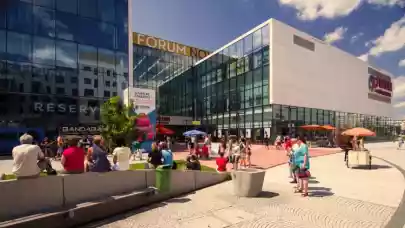“With €13.23 billion in 2018, the CEE commercial real estate investment volume recorded an 11% increase over 2017, and for the third year running set a new record transaction volume for the region. We have seen the most significant volume increase in Poland in 2018 with €7.2 billion traded, a substantial uplift in volumes over previous years. For 2019, we expect continued, strong interest for product in CEE markets although perhaps not quite matching the spectacular levels seen last year. One of the most interesting aspects has been the growth of domestic capital in the Czech Republic and Hungary with 50% and 60% of volumes respectively coming from domestic capital sources. We expect this to continue in 2019. Our current forecast for the full year suggests that CEE regional volumes will total around €11.0 billion for 2019“, says Mike Atwell, Head of Capital Markets Czech Republic & CEE, JLL.

Mike Atwell
Head of Capital Markets Czech Republic and Lead Director CEE
JLL
As Head of Capital Markets for the Czech Republic and Lead Director for Central and Eastern Europe, Mike oversees a team of more than 30 capital markets experts across CEE. His responsibilities include setting overall business development strategy for JLL's capital markets activities in CEE and the Czech Republic specifically, working closely with local and regional teams. Mike brings to JLL more than 30 years of experience in international real estate consulting, including 13 years in Central Europe during which he was involved in some of the highest profile transactions across the region. More »
Challenges of 2019
For 2019, JLL expects continued, strong interest for product in the CEE markets although perhaps not to quite to levels seen in 2018. JLL’s current forecast for the full year suggests that CEE regional volumes will reach ca. €11.0 billion. In addition, JLL assumes that in some countries the share of local investors will increase compared to those from abroad.
Czech Republic – a safe bet
The Czech Republic still reports strong macro-economic performance and continues to be considered as the most stable country with the lowest investment risk rating within the CEE region.
Office, industrial as well as retail occupational markets have registered strong performance, leading to record low vacancies across the sectors, supporting the strong fundamentals of the real estate investment market. On the basis of positive macro-economic results, the Czech Republic continues to be highly popular amongst both international and domestic capital. The volume of investments remained very strong, especially in the second half of the year, reaching an annual total of € 2.51 billion. Unlike most other CEE countries, Czech domestic investors dominated the market with a 50% share of volumes, followed by a 40% share of capital coming from Germany.
Investor activity and appetite for investment product continues to be strong, however, it is limited by a lack of supply of prime assets and high price expectations of sellers. This has resulted in lower 2018 investment volumes on the Czech real estate market by approximately 29% compared to 2017. However, the Czech Republic confirms its role as one of the most attractive destinations in the CEE region in all sectors.
In H2 2018, JLL recorded further yield compression with their view on prime yields as follows: prime offices compressed to 4.50%, prime shopping centres remained at 4.85% and the industrial and logistics prime yield stands at 5.50%. Prime retail parks are at 6.00% while prime high-street assets would trade at 3.50%.
According to JLL, the total office investment volume recorded for H2 2018 reached €502 million, accounting for approximately 36% of the total investment volume. Thanks to high occupancy and strong demand, Prague keeps its key destination status. The most significant office transactions in H2 2018 were the acquisition of Trimaran and Element by Allianz Real Estate, followed by Forum Karlin being sold to Amundi Czech Republic and Florence Office Center being sold to Korean investor, Shinhan.
The most significant retail transaction of H2 2018 was the acquisition of Forum Nova Karolina by REICO. The remaining retail transactions were regional shopping centres, supermarkets and retail parks, typically acquired by Czech domestic investors.
With the largest transaction of the year being the acquisition of a CTP portfolio by Deka Immobilien worth €458 million, the industrial and logistics sector volume totalled €488 million in H2 2018.
Poland, historically the largest volume of investment
The Polish investment market, which saw about €5.0 billion traded in 2017, continued to grow for the 4th consecutive year with an impressive 2018 year-end result of €7.2 billion traded. This volume was unprecedented and so far outperformed the previous best result for country investment volumes (2006) by almost €2.2 billion. 2018 was a unique year in Poland for many reasons. It saw the noticeable yield compression in most asset classes. There were almost 100 transactions concluded throughout the year including the biggest retail portfolio sale in the history of the Polish market (€1.0 billion), the largest number of portfolio transactions traded in a single year in the industrial sector (7) and the highest investment volumes reported in the main sectors: office (€2.75 billion), retail (€2.47 billion) and industrial (€1.84 billion).
"Since 2012, investments in commercial real estate in the CEE region have been growing at a swift pace, with an average of 40% per annum, and in 2018 we have historically recorded the highest investment volume - over €13 billion. This trend and the ever-expanding mix of investors show that we are a strategically important region. The Polish market itself attracted 20% of all Asian investments in 2018. We assume that the Czech Republic is still expecting this Asian wave to come", said Hana Kollmanová, Director of JLL Capital Markets.
Although the first half of 2018 started weak for Hungary, the second half of the year proved to be especially strong, reaching a level of €1.3 billion, the highest H2 volume since 2007. The strong volume was the result of four large transactions, which generated nearly 60% of the total volume. As a result, the most active sectors were offices (45%) and retail (41%), followed by hotels (6%), industrial (4%) and assets for development purposes (4%).
According to JLL, in 2018, the property investment volume for Romania is estimated at ca. €900 million, a value slightly below the one registered in 2017 (€963 million). However, several transactions in different stages of negotiations were postponed and they are most likely be concluded during the first half of 2019. The overall number of transactions decreased, although, the average deal size increased, standing at approximately €31 million. Bucharest accounted for over 78% of the total investment volume. Market volumes were dominated by office transactions (50%), while retail accounted for 35%.
Following robust investment activity in 2016 and 2017, the Slovak investment market has experienced yet another strong year resulting in a 2018 transactional volume of €820 million, much more than expected by JLL (€650 million).
The sector split of income-producing assets comprised €340 million in retail, €265 million in office, €170 million in industrial and €9 million in hotels. Compared to the 4-year averages, the retail sector performed 85% above the average level; the office sector had the highest investment volume ever achieved at 180% above average and the industrial sector recorded a 6% decline caused mainly by a lack of product and some deals remaining in the disposal process. Positive macroeconomic and market conditions, high occupancy rates, GDP growth and economic and political stability are the reasons why Slovakia is attracting more and more investors. The outlook for 2019 is therefore very optimistic.





